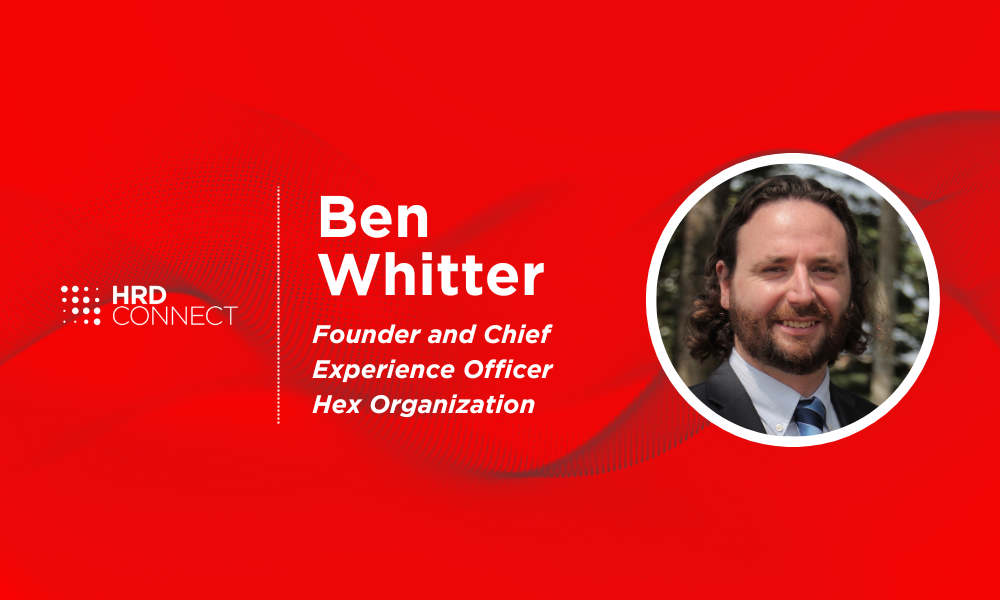Co-creating EX strategy to avoid transactional HR
- 6 Min Read
Ben Whitter joins HRD for an exclusive Q&A on EX, from co-creation to cross-fertilization with customer experience.
- Author: Benjamin Broomfield
- Date published: Jun 15, 2023
- Categories

Companies that invest in employee experience (EX) outperform those that don’t. The so-called ‘experiential organizations,’ such as Adobe or American Express that look beyond quick fixes for employee engagement toward long-term, carefully designed EX strategies, are home to happier employees and more profitable, productive, and innovative.
In this Q&A interview, we delve into the world of employee experience (EX) strategy with leading EX expert Ben Whitter. As organizations strive to create a more meaningful and engaging work environment, Whitter emphasizes the importance of co-creation and alignment. From shifting hierarchical mindsets to learnings from customer experience teams, Whitter provides thought-provoking insights and practical advice for HR leaders looking to develop effective EX strategies that align with overall business goals.
1. How is designing an effective employee experience strategy different from traditional approaches to HR strategy?
Ben Whitter: A major shift away from the usual way of developing strategy is the level of involvement from employees themselves. The best organizations found and build high-quality EX strategies on co-creation.
Real co-creation enables businesses to traverse the gaping chasms that have opened between employees and management because of radically different, and often competing, expectations of how employees should experience work. It is about finding ways to align and unify the entire organization through daily moments, experiences, and interactions that bring people and the organization closer together.
It also enables all functions and services that impact the employee journey to co-create and be accountable for outcomes and performance. If EX only sits within one function or department, or only a select few executives have developed it, something has gone fundamentally wrong. EX is a holistic business approach. Organizations must reflect this in the way they create and deliver EX strategy.
2. How can companies with a hierarchical structure and traditional approach to management shift their mindset?
Ben Whitter: Given the vast array of touchpoints that managers are involved with, companies will need to deepen their human-centric capabilities. They will need to review structures with the human-being in mind. This leads to changes in organizational design and how the organization develops. Building an EX strategy without managers as a key consideration misses the point.
The team experience is such a valuable and high-impact area of the EX that companies should place a high emphasis on aligning the leadership community from day one of the EX strategy. Companies need to prioritize capabilities for managers. Namely, connection, communication, and co-creation.
The leader is the ultimate connector and bridge to business and human outcomes, yet co-creation and human-centered communication is lacking up and down the economy. This is where I suggest managers double down to help them navigate the experience economy. They should focus on co-creating a positive team experience, connecting people to experiences that enable growth and progress, and communicating in a way that builds trust, understanding, and respect. Like anything, we can only shift mindsets through our experiences. Businesses need to think more carefully about the leadership experience within their company.
3. What can HR leaders learn from customer experience teams when designing their EX strategy?
Ben Whitter: We have already seen a great deal of knowledge exchange and cross-fertilization from CX to EX, and vice-versa. EX teams have ramped up journey mapping, persona development, design thinking, agile methodologies, insight, and analytics after the success of these strategies within CX.
But there is a limit. Employees are not customers. They have a special relationship with their companies that goes far beyond the transactional. Treating employees as customers is one of the most flawed ideas in the field. It’s something I strongly discourage. It gives employees a free pass to be passive, wait for organizations to serve them, or simply use services from teams like HR. In that role, they are merely consumers of HR services, which sets up the worst possible relationship with them.
Employees are the primetime creator of their careers. Performance experience and EX teams or organizations are there to enable employees to be as good as they can be. In that sense, they are both producers and consumers of EX; or ‘prosumer’ as I put it in Employee Experience (2022).
4. Do you have some practical advice for HR Leaders on ensuring that their EX strategies align with overall business strategy?
Ben Whitter: It is rule 101 of EX to completely tie it to the business strategy. We do this by connecting to objectives that matter most to the company and the Truth of the organization (an organization’s purpose, mission, and values). EX exists to bring those major elements to life through the daily experience of work.
To do this, HR leaders should consider if the EX truly immerses people into the brand. Is it a unifying force for actions and behavior? Does it directly connect people at all touch points to the Truth of the organization? Unmet expectations and broken promises are EX killers. Cross-functional alignment will need to be ramped up from the outset of the EX strategy.
Step One: Bring all the functions that touch the EX together. Step Two: Co-create objectives and outcomes from there. It is not an HR policy. It is a vital business strategy. Organizations should treat it as such.
5. What people or stakeholders should HR leaders be working with to develop an effective EX strategy?
Ben Whitter: I discuss this in my upcoming book, EX Strategy. It is so important to get right. There are so many potential co-creation partners to bring into this work to help lead it into the business. We start with employees, workers, and customers as a key co-creation group alongside all the support functions that influence and impact EX performance.
It is a silo-bashing approach. So, for the greatest chance of success, organizations will need to co-create it from the early days of the work. Sponsors, C-suite members, and functions like HR, marketing, finance, estates, and IT will be key parts of the overall EX team and approach.
________________
Ben Whitter was recognized by Thinkers50 as one of the World’s leading management thinkers in 2021. He is regarded as the world’s leading authority on employee experience. His compelling work has reached over 18 million colleagues worldwide.
His latest book, Employee Experience Strategy: Design an Effective EX Strategy to Improve Employee Performance and Drive Business Results, is now available for pre-order.










